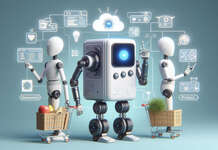Computers already surpass imagination with their computing power. However, in many ways, the human brain is still superior due to its complexity. Will this soon be a thing of the past? This question is fundamental in the field of artificial intelligence (AI) research. In this field, we seek to use computer science, neurology, psychology, and linguistics to technically recreate the brain and its functions.
What is AI or artificial intelligence?
Artificial intelligence is, by definition, a subfield of computer science that aims to create a technical equivalent of human intelligence. However, there are many theories and methodological approaches to what intelligence is and how it can be technically emulated. Therefore, it is difficult to offer a precise definition of artificial intelligence due to the complexity of the concept of intelligence itself.
There are also disagreements regarding the “similarity relationship” with the human being: should the machine be built exactly the same as a human brain? This simulation approach aims for an exact replication of brain functions. Or perhaps, should the machine act like a human being, that is, resemble him only in the final result? This phenomenological approach deals exclusively with what humans perceive of artificial intelligence, regardless of the technical process behind it.
Today, artificial intelligence is developed mostly for technical tasks. The goal is not so much for AI to master human communication, but for it to effectively perform highly specialized tasks. For these software development services, the Turing test is used: if a technical system has the same capabilities as a human being in a subfield (for example, in a medical diagnosis or in a game of chess) it is called an artificially intelligent system. Consequently, there are two definitions of artificial intelligence: one “strong” and one “weak.”
Strong artificial intelligence: vision
The definition of strong AI refers to an intelligence capable of replacing the human being in its entirety, with all its various capabilities. This universal approach to the human being as a machine has existed since the Enlightenment, but it remains fiction. There are different dimensions of intelligence that belong to strong AI: cognitive, sensorimotor, emotional, and social. Most current applications of artificial intelligence mainly focus on the field of cognitive intelligence, such as logic, planning, problem-solving, autonomy, and the formation of individual perspectives.
Weak artificial intelligence: the reality
The definition of weak AI, on the other hand, refers to the development and use of artificial intelligence in clearly defined areas of application. This is the stage current AI research is at. Almost all current fields of application of artificial intelligence belong to the realm of weak, but highly specialized AI. This includes the development of autonomous vehicles, medical diagnostics, intelligent search algorithms, and automation, among other examples.
In the area of weak AI, research has made revolutionary advances in recent years. The development of intelligent systems in specific areas has proven to be not only more feasible from a practical point of view but also ethically less controversial than research into superintelligence. The fields of application of weak artificial intelligence are extremely diverse, but it is used with particular success in medicine, finance, the transportation industry, and marketing… and, of course, on the Internet.
How does artificial intelligence work?
How can we describe the functioning of artificial intelligence? An AI is only as good as its technical representation of knowledge. In this sense, there are two basic methodological approaches: the symbol processing approach and the neural approach.
- In the symbol processing approach to AI, knowledge is represented through symbols and is realized by manipulating them. Symbolic AI focuses on top-down information processing and operates using symbols, abstract connections, and logical conclusions.
- In the neural approach to AI, knowledge is represented by artificial neurons and their interconnections. Neural AI focuses on bottom-up information processing and simulates functions of individual artificial neurons that are grouped into larger neural networks. These artificial neural networks work together to perform specific tasks.
Symbolic AI
Symbolic AI is considered the classic approach to artificial intelligence. It is based on the premise that human thought can be reconstructed from a higher logical-conceptual level, independently of specific empirical details (top-down approach). In this approach, knowledge is represented by abstract symbols, including written and spoken language. Machines learn to recognize, understand, and use these symbols through algorithms. The intelligent system acquires its information from expert systems, which are systems designed to store and apply specialized knowledge in a specific domain.
Classic applications of symbolic AI focus on word processing, language recognition, and other logical disciplines such as chess mastery. Symbolic AI is based on established rules and can solve increasingly complex problems as the computing power of computers increases. For example, IBM’s Deep Blue defeated then-world chess champion Garri Kasparov in 1996 with the help of symbolic AI.
Neural AI
In 1986, Geoffrey Hinton and two of his colleagues resurrected neural AI research and with it the field of artificial intelligence research. With their refinement of the backpropagation algorithm, they created the basis of Deep Learning, with which almost all AIs work today. Thanks to this learning algorithm, deep neural networks can constantly learn and grow independently, thus overcoming challenges where symbolic AI fails.
Like the human brain, neural artificial intelligence divides knowledge into smaller functional units, known as artificial neurons, which are connected in a network forming increasingly larger groups (bottom-up approach). The result is an artificial neural network with multiple branches. Unlike symbolic AI, the neural network is “trained” using sensorimotor data, as occurs in robotics. Through these experiences, AI generates constantly growing knowledge. Here lies the big innovation: although training may take time, the system is ultimately capable of learning autonomously.
Artificial intelligence: examples of applications and projects
Whether it is facial recognition, voice assistance, or translation programs, artificial intelligence has been present in our daily lives for a long time. Even if we consciously decide to do without these tools, it is difficult to escape the influence of AI in the digital environment. For example, behind product suggestions in online stores or recommendations on platforms such as YouTube, Netflix, and similar, there are AI systems that adapt to offer increasingly precise and appropriate recommendations.
Below we list some examples of the use of artificial intelligence:
- ChatGPT – ChatGPT is an AI-based chatbot developed by OpenAI. The software understands natural language text input and can, among other things, answer questions and create, paraphrase, and translate texts.
- RankBrain: RankBrain, developed by Google, is an AI algorithm initially designed to understand long, unknown search queries more effectively. In 2015, Google revealed that RankBrain was the third most relevant factor among the more than 200 ranking factors in its search engine, along with links and content. Therefore, RankBrain exerts a significant influence on SEO.
- DeepMind: DeepMind is a company purchased by Google in 2014 that has created numerous innovative AI technologies, such as AlphaGo, the computer program that perfectly mastered the board game “Go.” In April 2023, Google announced the merger with its internal AI division Google Brain. One of the special features of DeepMind’s AI research is that the company adds short-term memory to artificial intelligence.
- Voice.ai: Voice.ai is an artificial intelligence-based program that allows you to interact in real time with the voices of famous personalities, such as Hollywood stars and other celebrities. In addition, you also have the option to make voice recordings. The software is trained through contributions from users, who can add their own voice recordings to create new vocal profiles.
- DALL-E: The DALL-E AI system, developed by OpenAI, has the ability to generate unique and stunning 2D and 3D images from written descriptions in a matter of seconds. The open beta version of the software has been available since September 2022. According to the custom software development company, more than two million images are created with the application every day.
Opportunities and risks of AI
From an optimistic attitude towards progress to an absolute rejection of technology, artificial intelligence generates very diverse reactions. This is mainly due to the positive and negative predictions about how these new custom software development services will transform our lives in the future. Below, we summarize the opportunities and risks, as well as the most significant advantages and disadvantages of AI.
Summary of the advantages and opportunities of artificial intelligence
The use of AI offers a whole series of advantages and opportunities. The main advantages of this technology focus on the workplace, its high performance, and the economic perspectives it offers.
Employment and work facilitation
This new technology has the potential to create valuable new jobs, as well as boost the overall economy. Experts agree that technology will have a drastic impact on the labor market. In particular, advocates of universal basic income see artificial intelligence as a great opportunity, as the traditional model of salaried work could become obsolete in the future. The simplifications brought about by AI offer the possibility of having more free time.
Comfort
Proponents of AI also highlight the advantages in terms of the considerable convenience that any technical innovation brings to everyday life. This applies to both autonomous vehicles and intelligent translation software, advances that are a boon for consumers.
Exceptional performance
AI also offers significant advantages in public benefit tasks. Machines have a lower error rate than humans and their performance is enormous. Especially in the healthcare sector and in the judiciary, the versatility of smart machines is seen as promising. Although experts do not expect judges, for example, to be replaced by artificial technology in the future, it can help recognize procedural patterns more quickly and reach objective sentences.
Economic advantages
Of course, the technology also promises great commercial benefits for the industries involved. According to the World Robotics Report 2022, the number of new industrial robots installed worldwide reached a new high of 517,385 units in 2021. This data demonstrates the impact and economic potential that AI can offer businesses.
Futuristic projects
Last but not least, artificial intelligence also stimulates the natural human impulse to explore: it is already being developed for the exploration of oil wells or for the control of robots on Mars. As technology advances, it is expected that the field of application of AI will continue to expand, opening up new possibilities for exploration and discovery in various fields.
Disadvantages and risks of AI
However, prominent experts, such as Elon Musk, a Silicon Valley icon, have warned about the risks of artificial intelligence, despite their own commitment to the technology. These critical voices are also supported by broader initiatives, such as the Future of Life Institute (FLI), a research and advocacy organization that regularly brings together renowned critics to call for a responsible approach to technology.
The inferiority of the human being
A possible risk that worries many and has often been the subject of science fiction is the development of a “superintelligence.” A superintelligence is a technology that optimizes itself and therefore becomes independent of humans. The relationship between humans and this super-intelligent technology could become problematic. Some skeptics believe humans could succumb to technology. However, researchers consider deliberately malicious AI almost impossible. However, many see a real risk in artificial intelligence so competent that its activities take on a life of their own.
Technology dependence
The increasing dependence of humans on technological systems is also a cause for concern. In areas such as medical care, where assistive robots are being tested, there are critical voices that point out that people are being monitored by these technical systems. In doing so, they risk giving up some of their privacy and self-determination. These concerns are not only evident in medicine, but also in relation to AI-assisted video surveillance or intelligent algorithms on the Internet.
Data protection and power distribution
Intelligent algorithms can process larger and larger data sets more efficiently. For eCommerce, in particular, this can be good news. However, data processing by AI technologies is increasingly difficult for consumers to understand and control.
Filter bubbles and selective perception
Network activist Eli Pariser cites so-called filter or information bubbles as another risk of artificial intelligence. If algorithms increasingly derive the content they offer users from their previous behavior (personalized content), the “worldview” offered will become increasingly narrower. AI technologies could encourage selective perception and thus reinforce a growing “ideological distance between individuals.”
Influence on opinion formation
Furthermore, according to critics, AI technologies could specifically influence public opinions. These fears focus on technologies that know users in detail or the use of social bots that influence public attitudes. As the intelligence of these technologies increases, the risk of influencing opinions is increasing, according to skeptical voices.
Conclusion on artificial intelligence
AI is one of the most interesting technologies of the coming years. Artificial intelligences are already used in a wide variety of applications. There is no doubt that AI, like other technological advances, will have an impact on our daily lives and in the professional field. However, humans as counterparts or operators are an essential component that will not be lost in the future. Especially through the automation of recurring tasks, we should save a lot of time in the future, which we can invest in other areas of life.
al issues. Nurturing in Fintech, Supply chain, AR VR solutions, Real estate, and other sectors vitalizing new-age technology, I see this space as a forum to share and seek information. Writing and reading give me more clarity about what I need.






